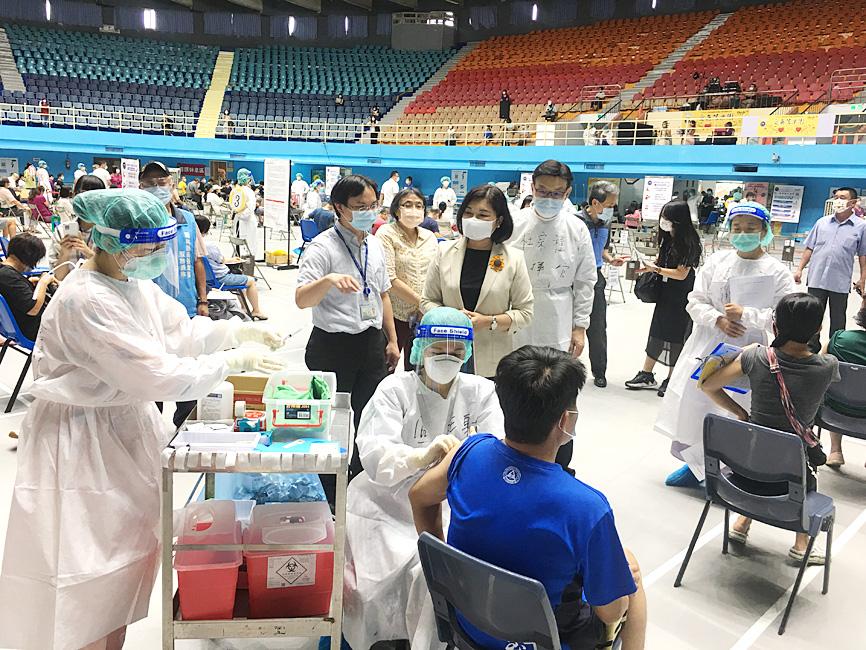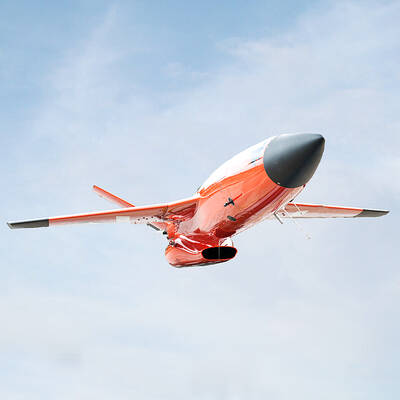The Advisory Committee on Immunization Practices (ACIP) yesterday agreed to a mix-and-match approach for COVID-19 vaccines, and approved the inclusion of Medigen Vaccine Biologics Corp’s (高端疫苗) COVID-19 vaccine in the national vaccination program.
Minister of Health and Welfare Chen Shih-chung (陳時中), who heads the Central Epidemic Command Center (CECC), said it was agreed at an ACIP meeting yesterday morning that a mix-and-match approach was acceptable for people receiving two doses of COVID-19 vaccines.
Most people in the first three COVID-19 vaccination priority groups have received a first dose of the AstraZeneca vaccine, Chen said.

Photo: Huang Shu-li, Taipei Times
Specialists in the committee said people in those groups should be allowed to receive a mRNA vaccine for their second dose, at least eight weeks after their first dose, he said.
However, to keep the vaccination policy consistent, the center would arrange for the second dose of the mix-and-match regimen to be administered 10 to 12 weeks after the first dose, he said.
Asked when the mix-and-match vaccination strategy would be implemented, Chen said that a date has not yet been set, as the ACIP’s decision was only reached at noon yesterday.
The CECC must still discuss plans for the strategy’s implementation, as well as modify the online vaccination booking system to allow for the mixing of doses, Chen said.
The ACIP also approved the domestic Medigen vaccine for inclusion in the national vaccination program, he said.
Regarding rollout of the Medigen vaccine, Chen said the CECC would need to meet with the vaccine maker to confirm its supply plan and schedule.
Medigen obtained Emergency Use Authorization for its vaccine from the Food and Drug Administration on Monday last week, the first local vaccine maker to do so.
The administration based its decision on data Medigen obtained in a phase 2 clinical trial involving about 4,000 participants earlier this year, which was analyzed using immunobridging and compared to a control group of 200 AstraZeneca vaccine recipients in Taoyuan.
Medigen has said it has permission to conduct a phase 3 clinical trial among 1,000 people in Paraguay.
Additional reporting by CNA

‘WIN-WIN’: The Philippines, and central and eastern European countries are important potential drone cooperation partners, Minister of Foreign Affairs Lin Chia-lung said Minister of Foreign Affairs Lin Chia-lung (林佳龍) in an interview published yesterday confirmed that there are joint ventures between Taiwan and Poland in the drone industry. Lin made the remark in an exclusive interview with the Chinese-language Liberty Times (the Taipei Times’ sister paper). The government-backed Taiwan Excellence Drone International Business Opportunities Alliance and the Polish Chamber of Unmanned Systems on Wednesday last week signed a memorandum of understanding in Poland to develop a “non-China” supply chain for drones and work together on key technologies. Asked if Taiwan prioritized Poland among central and eastern European countries in drone collaboration, Lin

The Chien Feng IV (勁蜂, Mighty Hornet) loitering munition is on track to enter flight tests next month in connection with potential adoption by Taiwanese and US armed forces, a government source said yesterday. The kamikaze drone, which boasts a range of 1,000km, debuted at the Taipei Aerospace and Defense Technology Exhibition in September, the official said on condition of anonymity. The Chungshan Institute of Science and Technology and US-based Kratos Defense jointly developed the platform by leveraging the engine and airframe of the latter’s MQM-178 Firejet target drone, they said. The uncrewed aerial vehicle is designed to utilize an artificial intelligence computer

Renewed border fighting between Thailand and Cambodia showed no signs of abating yesterday, leaving hundreds of thousands of displaced people in both countries living in strained conditions as more flooded into temporary shelters. Reporters on the Thai side of the border heard sounds of outgoing, indirect fire yesterday. About 400,000 people have been evacuated from affected areas in Thailand and about 700 schools closed while fighting was ongoing in four border provinces, said Thai Rear Admiral Surasant Kongsiri, a spokesman for the military. Cambodia evacuated more than 127,000 villagers and closed hundreds of schools, the Thai Ministry of Defense said. Thailand’s military announced that

CABINET APPROVAL: People seeking assisted reproduction must be assessed to determine whether they would be adequate parents, the planned changes say Proposed amendments to the Assisted Reproduction Act (人工生殖法) advanced yesterday by the Executive Yuan would grant married lesbian couples and single women access to legal assisted reproductive services. The proposed revisions are “based on the fundamental principle of respecting women’s reproductive autonomy,” Cabinet spokesperson Michelle Lee (李慧芝) quoted Vice Premier Cheng Li-chiun (鄭麗君), who presided over a Cabinet meeting earlier yesterday, as saying at the briefing. The draft amendment would be submitted to the legislature for review. The Ministry of Health and Welfare, which proposed the amendments, said that experts on children’s rights, gender equality, law and medicine attended cross-disciplinary meetings, adding that